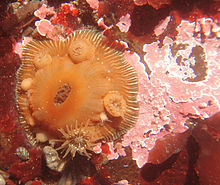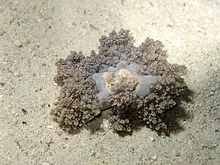- Sea anemone
-
Sea anemones 
Various examples of sea anemones Scientific classification 
Kingdom: Animalia Phylum: Cnidaria Class: Anthozoa Subclass: Hexacorallia Order: Actiniaria Suborders - Endocoelantheae
- Nyantheae
- Protantheae
- Ptychodacteae
Diversity 46 families  The 49th plate from Ernst Haeckel's Kunstformen der Natur, 1904, showing various sea anemones classified as Actiniae
The 49th plate from Ernst Haeckel's Kunstformen der Natur, 1904, showing various sea anemones classified as Actiniae
Sea anemones are a group of water-dwelling, predatory animals of the order Actiniaria; they are named after the anemone, a terrestrial flower. Sea anemones are classified in the phylum Cnidaria, class Anthozoa, subclass Zoantharia.[1] Anthozoa often have large polyps that allow for digestion of larger prey and also lack a medusa stage.[2] As cnidarians, sea anemones are closely related to corals, jellyfish, tube-dwelling anemones, and Hydra.
Contents
Anatomy
A sea anemone is a polyp attached at the bottom to the surface beneath it by an adhesive foot, called a basal disc, with a column shaped body ending in an oral disc. Most are from 1.8 to 3 centimetres (0.71 to 1.2 in) in diameter, but anemones as small as 4 millimetres (0.16 in) or as large as nearly 2 metres (6.6 ft) are known.[3] They can have anywhere from a few tens to a few hundred tentacles.
A few species are pelagic, and are not attached to the bottom; instead they have a gas chamber within the pedal disc, allowing them to float upside down in the water.[4]
The mouth is in the middle of the oral disc surrounded by tentacles armed with many cnidocytes, which are cells that function as a defense and as a means to capture prey. Cnidocytes contain nematocyst, capsule-like organelles capable of everting, giving phylum Cnidaria its name.[5] The cnidae that sting are called nematocysts. Each nematocyst contains a small vesicle filled with toxins (actinoporins), an inner filament, and an external sensory hair. When the hair is touched it mechanically triggers the cell explosion, a harpoon-like structure which attaches to organisms that trigger it, and injects a dose of poison in the flesh of the aggressor or prey. This gives the anemone its characteristic sticky feeling. The sea anemone eats small fish and shrimp.
The poison is a mix of toxins, including neurotoxins, which paralyzes the prey and allows it to be moved to the mouth for digestion inside the gastrovascular cavity. Actinoporins have been reported as highly toxic to fish and crustaceans, which are the natural prey of sea anemones. In addition to their role in predation, it has been suggested that actinoporins could act, when released in water, as repellents against potential predators[citation needed]. Anemonefish (clownfish), small banded fish in various colors, are not affected by their host anemone's sting and shelter themselves from predators within its tentacles.[6]
The internal anatomy of anemones is quite complex.
Digestive system
There is a gastrovascular cavity (which functions as a stomach) with a single opening to the outside which functions as both a mouth and an anus; waste and undigested matter is excreted through the mouth/anus, which can be described as an incomplete gut. The mouth is typically slit-like in shape, and bears a groove at one or both ends. The groove, termed a siphonophore, is ciliated, and helps to circulate water through the gastrovascular cavity.[4] Some anemones feed on small particles, which are caught with the aid of a mucus secretion and moving currents that are set up by the tentacles. Most sea anemones are predacious, immobilizing their prey with the aid of their nematocysts.[1]
The mouth opens into a flattened pharynx. This consists of an in-folding of the body wall, and is therefore lined by the animal's epidermis. The pharynx typically runs for about two-thirds the length of the body before opening into the gastrovascular cavity that fills the remainder of the body.
The gastrovascular cavity itself is divided into a number of chambers by mesenteries radiating inwards from the body wall. Some of the mesenteries form complete partitions with a free edge at the base of the pharynx, to which they connect, but others reach only partway across. The mesenteries are usually found in multiples of twelve, and are symmetrically arranged around the central pharynx. They have stomach lining on both sides, separated by a thin layer of mesoglea, and includes filaments of tissue specialised for secreting digestive enzymes. In some species these filaments extend below the lower margin of the mesentery, hanging free in the gastovascular cavity as acontial filaments.[4]
Nervous system
A primitive nervous system, without centralization, coordinates the processes involved in maintaining homeostasis as well as biochemical and physical responses to various stimuli. There are no specialized sense organs.
The muscles and nerves are much simpler than those of most other animals, although more specialised than in other cnidarians, such as corals. Cells in the outer layer (epidermis) and the inner layer (gastrodermis) have microfilaments that group into contractile fibers. These fibers are not true muscles because they are not freely suspended in the body cavity as they are in more developed animals. Longitudinal fibres are found in the tentacles and oral disc, and also within the mesenteries, where they can contract the whole length of the body. Circular fibers are found in the body wall and, in some species, around the oral disc, allowing the animal to retract its tentacles into a protective sphincter.[4]
Since the anemone lacks a skeleton, the contractile cells pull against the gastrovascular cavity, which acts as a hydrostatic skeleton. The anemone stabilizes itself by shutting its mouth, which keeps the gastrovascular cavity at a constant volume, making it more rigid. Although generally sessile, sea anemones are capable of slow movements using their pedal disc, or of swimming, using either their tentacles or by flexing their body.
Life cycle
Unlike other cnidarians, anemones (and other anthozoans) entirely lack the free-swimming medusa stage of the life cycle; the polyp produces eggs and sperm, and the fertilized egg develops into a planula that develops directly into another polyp.
Anemones tend to stay in the same spot until conditions become unsuitable (prolonged dryness, for example), or a predator attacks them. In that case anemones can release themselves from the substrate and use flexing motions to swim to a new location. Most sea anemones attach temporarily to submerged objects; a few thrust themselves into the sand or live in burrows; a few are parasitic on other marine organisms [1] and some have symbiotic relationships with hermit crabs.
The sexes in sea anemones are separate in some species, while other species, like the brooding anemone (Epiactis prolifera), are protandric hermaphrodites. The gonads are strips of tissue within the mesenteries. Both sexual and asexual reproduction can occur. In sexual reproduction males release sperm to stimulate females to release eggs, and fertilization occurs. Anemones eject eggs and sperm through the mouth. The fertilized egg develops into a planula, which settles and grows into a single polyp.
Anemones can also reproduce asexually, by budding, binary fission (the polyp separates into two halves), and pedal laceration, in which small pieces of the pedal disc break off and regenerate into small anemones.
Ecology
 Venus' fly-trap anemone (Actinoscyphia) in the Gulf of Mexico
Venus' fly-trap anemone (Actinoscyphia) in the Gulf of Mexico
The sea anemone has a pedal disc, which the organism uses to attach itself to rocks or which it anchors in the sand. Others also burrow into a stronger object. Some species attach to kelp while others are free-swimming. Although not plants and therefore incapable of photosynthesis themselves, many sea anemones form an important facultative symbiotic relationship with certain single-celled green algae species which reside in the animals' gastrodermal cells. These algae may be either zooxanthellae, zoochlorellae or both. The sea anemone benefits from the products of the algae's photosynthesis, namely oxygen and food in the form of glycerol, glucose and alanine; the algae in turn are assured a reliable exposure to sunlight and protection from micro-feeders, which the sea anemones actively maintain. The algae also benefit by being protected due to the presence of stinging cells called nematocysts, reducing the likelihood of being eaten by herbivores. Most species inhabit tropical reefs, although there are species adapted to relatively cold waters, intertidal reefs, and sand/kelp environments.
Exploitation
The global trade of marine ornamentals has been a rapidly expanding industry involving numerous countries worldwide. In the early 1980s, the estimated value of imported marine fish and invertebrates was US$24–40 million annually.[7] Current estimates place that value at US$200–330 million,[8] with the United States accounting for 80% of the industry imports.[9] Despite advances and the expansion of aquaculture, post-larval capture and rearing, the majority of marine ornamentals are collected in the wild as adults or juveniles.[10] Anemones are susceptible to overexploitation due to their long life spans, slower relative growth rates, and lower reproductive rates than their resident fish, which are also affected due to the fact that they settle exclusively and are restricted to specific host sea anemones. The demand for these organisms is reflected in fishermen's catch records, which document the value they are paid per catch, and on average sea anemones were valued at five times the average value of anemonefish, and ten times the value of the most abundant anemonefish, and in fact only made up 4.1% of the total value of the catch. Research has shown that aquarium fishing activities significantly impact the populations of anemones and anemonefish by drastically reducing the densities of each in exploited areas,[10] and could also negatively impact anemone shrimp, and any organisms obligately associated with sea anemones. It should be noted that anemonefish can survive alone in captivity, as has been shown by multiple research efforts.[11][12]
Fossil record
Most Actiniaria do not form hard parts that can be recognized as fossils but a few fossils do exist; Mackenzia, from the Middle Cambrian Burgess Shale of Canada, is the oldest fossil identified as a sea anemone.
See also
- AETX
- Sea anemone dermatitis
- Sea anemone neurotoxin
References
- ^ a b c "Sea anemone". Columbia Encyclopedia (6th ed.). 2008. http://www.encyclopedia.com/doc/1E1-seaanemo.html.
- ^ Peter Castro & Michael E. Huber (2010). Marine Biology. New York: McGraw-Hill. p. 121.
- ^ "Sea Anemones – info and games". sheppardsoftware.com. http://sheppardsoftware.com/content/animals/animals/invertebrates/seaanemone.htm. Retrieved November 20, 2010.
- ^ a b c d Robert D. Barnes (1982). Invertebrate Zoology. Philadelphia, PA: Holt-Saunders International. pp. 150–157. ISBN 0-03-056747-5.
- ^ N. Campbell & J. Reece (2002). Biology (6th ed.). San Francisco: Pearson Education. ISBN 9780805300093.
- ^ "Fagatele Bay NMS: Clownfish and Sea Anemone". National Marine Sanctuaries. January 12, 2006. http://sanctuaries.noaa.gov/pgallery/pgfagatele/living/living_03_100.html. Retrieved November 20, 2010.
- ^ Eliabeth M. Wood (1985). Exploitation of Coral Reef Fishes for the Aquarium Trade. Report to the Marine Conservation Society.
- ^ Frank A. Chapman, Sharon A. Fitz-Coy, Eric M. Thunberg, Charles M. Adams (1997). "United States of America trade in ornamental fish" (PDF). Journal of the World Aquaculture Society 28 (1): 1–10. doi:10.1111/j.1749-7345.1997.tb00955.x. http://fishweb.ifas.ufl.edu/Faculty%20Pubs/Chapman%20Pubs/ChapmanOrnFishTrade.pdf.
- ^ Sherry L. Larkin & Robert L. Degner (2001). "The U.S. wholesale market for marine ornamentals". Aquarium Sciences and Conservation 3 (1–3): 13–24. doi:10.1023/A:1011329300967.
- ^ a b Craig S. Shuman, Gregor Hodgson & Richard F. Ambrose (2005). "Population impacts of collecting sea anemones and anemonefish for the marine aquarium trade in the Philippines" (PDF). Coral Reefs 24 (4): 564–573. doi:10.1007/s00338-005-0027-z. http://www.reefcheck.org/PDFs/Coral_Reefs_24_4_Shuman_Hodgson_Ambrose.pdf.
- ^ Daphne Gail Fautin (1991). "The anemonefish symbiosis: what is known and what is not" (PDF). Symbiosis 10: 23–46. http://www.nhm.ku.edu/inverts/pdf/Fautin_anemonefishsymbiosis_1991.pdf.
- ^ Ronald L. Shimek (2004). Marine Invertebrates. Neptune City, NJ: T.F.H. Publications. p. 83. ISBN 9781890087661.
External links
- Order Actiniaria
- Actiniaria.com
- Photos of various species of Sea Anemones from the Indopacific
- Anemone Armies Battle to a Standoff
- Anemone Wars: Clone armies deploy scouts, attack tidally – unsuspected military tactics
- Sea anemones look like sea flowers but they are animals of the Phylum Cnidaria
- Information about Ricordea Florida Sea anemones & pictures
- Photographic Database of Cambodian Sea Anemones
- Photos of Sea Anemones
Categories:- Actiniaria
Wikimedia Foundation. 2010.


